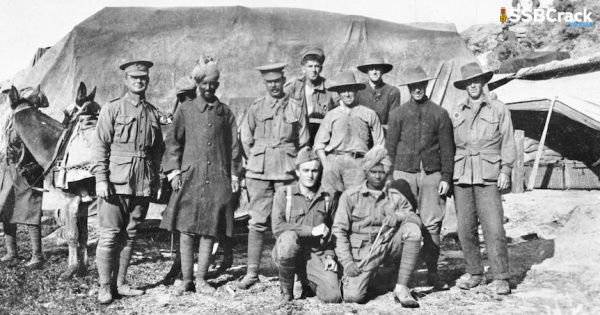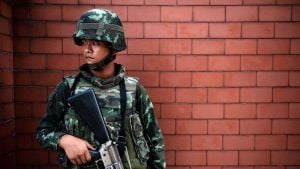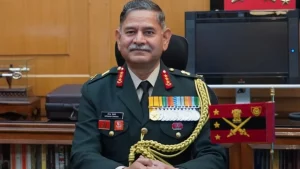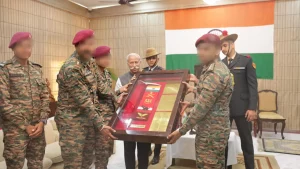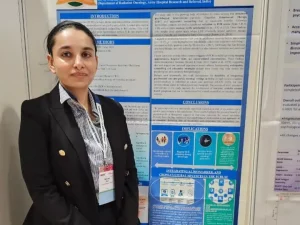In 1915 some 16,000 troops of the Indian Army – including Gurkhas, Sikhs, Muslims, and Hindus – served as part of the British force involved in the dramatic eight-month Gallipoli campaign in Turkey during World War I. About 1600 Indian troops, one man in 10, died while serving alongside Australian, New Zealand, and British soldiers whose part in the Great War has been extensively documented. The Indians have had to wait a century for their story to be told.
Stories of Indian soldiers like Jan Mahomed, whose orders were accepted by thirsty Australians when he controlled a well under fire; Karam Singh, who continued to give orders to his gunners though blinded; and Subedar Gambirsing Pun, who commanded the Gurkhas in the fight for the Gallipoli summit.
“Despite barriers of language, culture and religion, it is clear that Australian and Indian soldiers had a deep respect for each other and bonded in battle,” Professor Stanley said. “I found in Australian diaries, letters and photographs evidence of how Indian soldiers experienced Gallipoli.”
Battle Honours
Battle Honours are awarded to military units as an official acknowledgement of their achievements in specific wars or battles of a military campaign. These honours usually take the form of a place and a date and are emblazoned on the colours of the units that are so honoured. Artillery units, which traditionally do not carry colours, are awarded honour titles instead. Units take great pride in their Battle Honours and especially hard-earned honours are commemorated annually by the celebration of selected “battle honour days”
Battle Honours awarded to units of the Indian Army in Gallipoli:
GALLIPOLI 1915
- 21st (Kohat) Mountain Battery (Frontier Force)
- 26th (Jacob’s) Mountain Battery
- 14th King George’s Own Ferozepore Sikhs
- 69th Punjabis
- 89th Punjabis
- 1-4th Gurkha Rifles
- 1-5th Gurkha Rifles (Frontier Force)
- 1-6th Gurkha Rifles
- 2-10th Gurkha Rifles
- Bharatpur Imperial Service Transport Corps
- Indore (Holkar’s) Imperial Service Transport Corps
HELLES
- 14th King George’s Own Ferozepore Sikhs
- 69th Punjabis
- 89th Punjabis
- 1-5th Gurkha Rifles (Frontier Force)
- 1-6th Gurkha Rifles
- 2-10th Gurkha Rifles
KRITHIA
- 14th King George’s Own Ferozepore Sikhs
- 69th Punjabis
- 89th Punjabis
- 1-5th Gurkha Rifles (Frontier Force)
- 1-6th Gurkha Rifles
- 2-10th Gurkha Rifles
ANZAC
- 21st (Kohat) Mountain Battery (Frontier Force)
- 26th (Jacob’s) Mountain Battery
LANDING AT ANZAC
- 21st (Kohat) Mountain Battery (Frontier Force)
- 26th (Jacob’s) Mountain Battery
DEFENCE OF ANZAC
- 21st (Kohat) Mountain Battery (Frontier Force)
- 26th (Jacob’s) Mountain Battery
SUVLA
- 21st (Kohat) Mountain Battery (Frontier Force)
- 26th (Jacob’s) Mountain Battery
- 14th King George’s Own Ferozepore Sikhs
- 1-5th Gurkha Rifles (Frontier Force)
- 1-6th Gurkha Rifles
- 2-10th Gurkha Rifles
- Bharatpur Imperial Service Transport Corps
- Indore (Holkar’s) Imperial Service Transport Corps
SARI BAIR
- 21st (Kohat) Mountain Battery (Frontier Force)
- 14th King George’s Own Ferozepore Sikhs
- 1-5th Gurkha Rifles (Frontier Force)
- 1-6th Gurkha Rifles
- 2-10th Gurkha Rifles
LANDING AT SUVLA
- Bharatpur Imperial Service Transport Corps
- Indore (Holkar’s) Imperial Service Transport Corps
SCIMITAR HILL
- Bharatpur Imperial Service Transport Corps
- Indore (Holkar’s) Imperial Service Transport Corps
A two-day International Conference on the historical significance of the 1915 Gallipoli campaign was organized jointly by the United Service Institution (USI) of India and the Indian Council of World Affairs (ICWA) on 22-23 April 2021. The Heads of the Diplomatic Missions of Australia, New Zealand, Turkey, and the Deputy High Commissioner of the UK were present.
Inaugurating the Conference, External Affairs Minister Dr S. Jaishankar said “This is the first major commemoration of the Battle of Gallipoli to be hosted by any platform of national significance in India. Their coming together with international participation has provided an opportunity to not only reflect on the Gallipoli campaign but also to assess India’s contribution to World War I.”
He added that Prime Minister Narendra Modi has taken a personal interest in this issue, speaking about it during his official visits to Australia, France, the UK, and Israel. Recognizing the political significance of Indian soldiering abroad, Prime Minister Narendra Modi himself set an example by visiting the Neuve Chapelle Memorial in France during his April 2015 visit and lauding Indian courage and sacrifice there. Two years later, during his historic visit to Israel, he similarly went to the Haifa Memorial that marks the sacrifices of Indian lives during its 1918 liberation.
A less reserved Indian embrace of its past was naturally reciprocated by the world. In November 2017, King Philippe and Queen Mathilde of Belgium recognized the contribution of Indian soldiers to the defence of Belgium by placing a wreath at India Gate and inaugurating an exhibition “India in Flanders Fields” in New Delhi. In January 2018, Prime Minister Modi and his Israeli counterpart Benjamin Netanyahu participated in the renaming ceremony of the Haifa-Teen Murti Memorial in New Delhi. In November 2018, Vice President Venkaiah Naidu, inaugurated the Indian Armed Forces Memorial at Villers Guislain in France, on land donated by the French Government to mark the contribution of Indian soldiers to the freedom of France during World War I.
The Minister emphasized that to “those who have been reluctant to recognize the significance of the Indian war effort in the 20th century, we could well ask whether the early experience of global engagement could have come without participation in these conflicts. And that is necessary to stress because these diplomatic exposures were really the foundational lessons in the evolution of India’s world view.”
Those resisting changes in the global order today justify their obduracy as adherence to the military contributions and outcomes of the last World War. But in truth, Gallipoli and other World War events underline that India was among the countries that were short-changed in this respect. Whether it is the past or the future, there is a strong case for global decision-making to be more truly representative.
India is today in the midst of reclaiming history and re-asserting its interests beyond orthodox silos
The Minister concluded by saying that India is today in the midst of reclaiming history and re-asserting its interests beyond orthodox silos. It is evident in the Act East policy, the Indo-Pacific vision, reviving ties with Gulf and West Asia, and the outreach to Africa. It is equally clear that connectivity – a concept that Gallipoli so strongly symbolizes – has become even more salient in the 21st-century Great Game. “As Indians look at the world with fresher and clearer eyes, global battlefields where we have shed blood to determine momentous outcomes are both a reminder and an inspiration.”
During the Conference, experts from Australia, New Zealand, Turkey, the UK, and India presented their views on the Gallipoli Campaign. Professor Peter Stanley, formerly Military Historian at the Australian War Memorial, made a major presentation on “Indians on Gallipoli”. He estimated that the total number of Indians who served on Gallipoli was 16,000, with just 10,000 Indian Army troops present on Gallipoli on or about 5 December 1915. Indian casualties were estimated as just over 1600 killed and about 4000 wounded, with an unknown number of men evacuated sick still to be identified. Among the units from the India that were deployed at Gallipoli were a mountain artillery brigade, a large supply and transport contingent and an enlarged infantry brigade, the 29th. By the end of the campaign, it comprised five battalions, including companies detached from the Patiala Rajendra Infantry.
Dr Christopher Pugsley of New Zealand provided images from digitized film archives that have led to the rediscovery of a rich vein of Gallipoli film taken by French Gaumont cameramen. He showed scenes of the Indian transport and supply companies, Indian medical services, and selected groups of wounded representing the fighting units of the Indian troops who served on the peninsula. These films were seen by audiences around the world but have been largely forgotten today.
India is today the single largest contributor of troops to UN peacekeeping
Ambassador Asoke Mukerji, Member of the Board of Management of the Centre for Military History and Conflict Studies at the United Service Institution of India put India’s participation in the Gallipoli Campaign in the context of her huge military and financial contribution to the Allied victory in the First World War.
As a result of this, the British Government under Prime Minister David Lloyd George was compelled to include India in the “special War Conference of the Empire” meetings that decided on the participation of the British Empire Delegation at the Paris Peace Conference, which negotiated and adopted the Treaty of Versailles on 28 June 1919. As a signatory of the Treaty of Versailles, India became a founder-member of the League of Nations, the first modern multilateral inter-governmental organization. India’s participation as part of the Allied armies in the First (and subsequently Second) World Wars directly led to her becoming a founder-member of contemporary structures of global governance.
This included the United Nations in 1945, where India is today the single largest contributor of troops to UN peacekeeping.
The importance of the Gallipoli Campaign for Australia was highlighted by Dr Rhys Crawley of the Australian War Memorial and Brigadier Chris Roberts of the University of New South Wales, while the New Zealand Defence Force Historian John Crawford and Lt. Col. Christopher Pugsley a freelance historian presented New Zealand’s perspective on this topic. Dr Mesut Uyar of Antalya Bilim University and Professor Mehmet Akif Okur from the Yildiz Technical University provided their viewpoint on the significance of Gallipoli for the Turkish Army and Turkey’s political history, respectively.
From the United Kingdom, Stephen Chambers the Historian of the Gallipoli Association and Professor Jenny MacLeod of Hull University provided the British military and political perspective respectively on Gallipoli. Thanking the speakers, the Chairman of the Board of Management of the Centre for Military History and Conflict Studies of the United Service Institution of India, Major General Ian Cardozo said that the breadth of the scope of the presentations underscored the impact of the Gallipoli campaign not only for military historians but also for the wider public, which would contribute to greater cooperation in remembering the huge sacrifices made during the conflict.
The Chief of Army Staff General M.M. Naravane delivered the Valedictory Address at the International Conference, stressing the importance of recognizing the high degree of professionalism of Indian soldiers and their valour and sacrifice, which was recognized globally.
The importance of this International Conference was meant to “better understand how different perceptions of the past that derive from a historical culture in different ways are used to provide a context for the present and shape the future” in the words of Dr T.C.A. Raghavan, Director General of the Indian Council of World Affairs. He recalled the words of the Indian military historian, Rana Chhina, who coordinated the International Conference, that “the lack of a political identity in 1915 served to rob Indian soldiers not just of an acknowledgement of their role, or of a commemoration of their sacrifice, but also of their place in history”. In his concluding remarks, Major General B.K. Sharma, Director of the United Service Institution of India expressed satisfaction at the wealth of knowledge that had been shared by the participants in the Conference, which would be used to take some specific initiatives, including for an Indian war memorial at Gallipoli.
(Article by Ambassador Asoke Mukerji, Former Permanent Representative of India to the United Nations)
Pic Credits: Australian War Memorial, State Library of South Australia, Rev Ernest Northcroft and respective sources.
